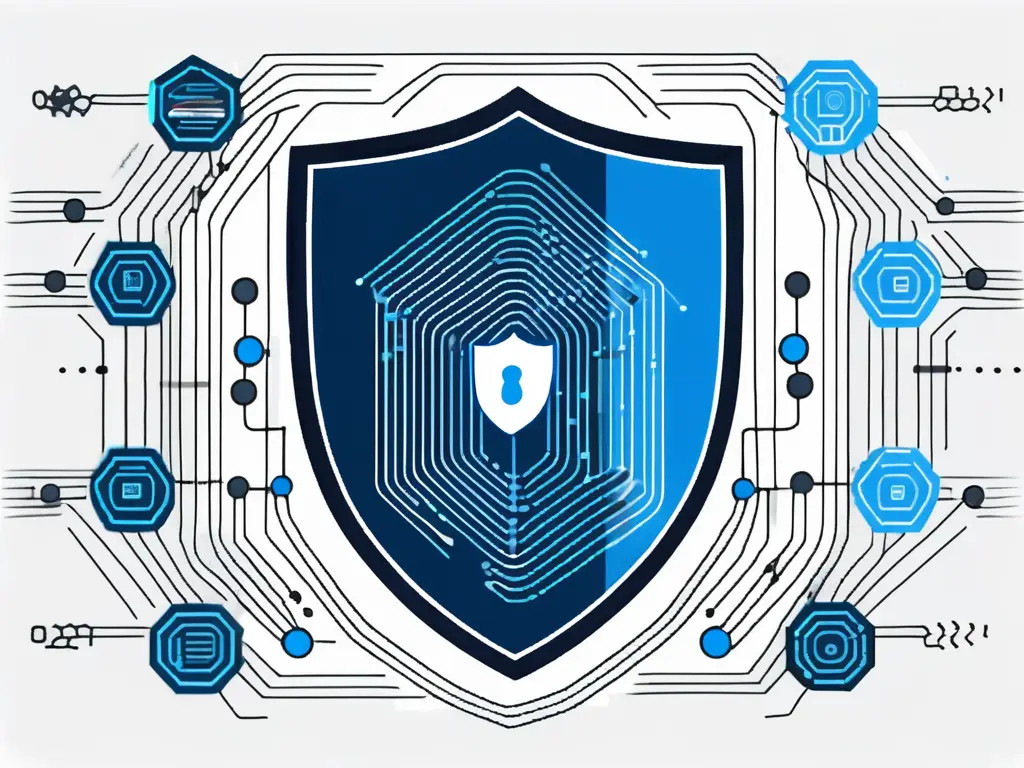Hamming Codes are crucial components of cybersecurity that play a significant role in ensuring data integrity and protecting against errors in data transmission. In this article, we will dive deep into the world of Hamming Codes, exploring their basics, mathematical foundations, and impact on error detection and correction. We will also examine the limitations and challenges of using Hamming Codes and their future prospects in the ever-evolving realm of cybersecurity.
Understanding the Basics of Hamming Codes
The Origin of Hamming Codes
Before we delve into the intricacies of Hamming Codes, it is essential to understand their origin. These codes were developed by Richard Hamming, a brilliant American mathematician and computer scientist, in the 1950s. Hamming’s pioneering work in error detection and correction laid the foundation for modern data integrity techniques.

Richard Hamming’s groundbreaking research was motivated by the growing need for reliable communication systems in the burgeoning field of computing. His innovative approach to error detection and correction revolutionized how data was transmitted and received, setting new standards for data integrity and reliability in digital communication.
The Mathematical Foundation of Hamming Codes
At the heart of Hamming Codes lies a fascinating mathematical concept—parity. Parity refers to the odd or even number of bits set to ‘1’ in a binary string. By strategically introducing parity bits into our data, we can detect and correct errors that occur during transmission. The mathematics behind Hamming Codes is truly remarkable, enabling us to safeguard our data against various anomalies.
The elegance of Hamming Codes lies in their ability to detect and correct errors. Through a clever arrangement of parity bits, Hamming Codes can pinpoint the exact bit altered during transmission and restore the original data with precision. This level of error correction capability has made Hamming Codes indispensable in critical applications where data accuracy is paramount, such as spacecraft communication systems and medical imaging devices.
The Role of Hamming Codes in Cybersecurity
Error Detection and Correction with Hamming Codes
One of the primary applications of Hamming Codes is error detection and correction. When data is transmitted over a network or stored in a memory system, errors can occur due to noise or hardware failures. With the help of Hamming Codes, we can detect and correct these errors, ensuring the integrity and accuracy of our data.

Hamming Codes are a type of linear error-correcting code named after Richard Hamming, who introduced them in the 1950s. These codes add extra bits to the data being transmitted or stored, allowing for detecting and correcting errors. By calculating parity bits based on the original data bits, Hamming Codes can identify where errors have occurred and even correct single-bit errors, providing a reliable method for data integrity.
Enhancing Data Integrity through Hamming Codes
As cyber threats become increasingly sophisticated, ensuring data integrity is paramount. Hamming Codes provide a robust mechanism to enhance data integrity, reducing the risk of unauthorized modifications or data corruption. By employing these codes, we can have confidence in the accuracy and trustworthiness of our valuable information.
Hamming Codes are widely used in digital communication systems, such as satellite communication, where errors in data transmission are common. By implementing Hamming Codes, these systems can automatically detect and correct errors, ensuring the transmitted information remains intact and reliable. This capability is crucial in critical applications where data accuracy is paramount, such as financial transactions or military communications.
How Hamming Codes Work in Cybersecurity
The Process of Encoding and Decoding Hamming Codes
Encoding and decoding Hamming Codes involve a series of well-defined steps. During encoding, we add redundant bits to our data to create code words containing information about the original message and error detection and correction capabilities. On the receiving end, decoding is performed to identify and correct any errors that may have occurred during transmission. This elegant process ensures the reliability and integrity of our data.
Hamming Codes are error-correcting codes that play a crucial role in cybersecurity. By incorporating redundancy into the data transmission process, Hamming Codes can detect and correct errors that may occur during communication. This capability is particularly important in sensitive applications where data accuracy is paramount, such as in financial transactions or critical infrastructure systems.
The Significance of Parity Bits in Hamming Codes
Parity bits are the backbone of Hamming Codes. They enable error detection and correction by adding an extra layer of redundancy to our data. Parity bits ensure that the sum of ‘1’ bits in a specific sequence adheres to a predetermined pattern. By comparing the received data with the expected parity pattern, we can identify and rectify errors, maintaining the consistency of our information.
One fascinating aspect of parity bits is their ability to detect errors and pinpoint the exact bit that is corrupted. This granular level of error identification allows for targeted correction, minimizing the impact of data discrepancies. As cybersecurity threats evolve, the robust error detection and correction mechanisms provided by Hamming Codes and parity bits remain essential for safeguarding sensitive information.
The Limitations and Challenges of Using Hamming Codes
Situations Where Hamming Codes May Fail
While Hamming Codes are highly effective in many scenarios, they have limitations. In certain situations, such as when errors occur in overlapping regions, they may not be able to detect or correct errors reliably. To ensure data integrity, it is essential to recognize these limitations and explore alternative error detection and correction techniques.

One specific scenario where Hamming Codes may struggle is in environments with high levels of electromagnetic interference. In such cases, the noise introduced can disrupt the parity bits used by Hamming Codes, leading to incorrect error detection and correction. This highlights the importance of considering external factors when implementing error control mechanisms.
Overcoming the Limitations of Hamming Codes
Although the Hamming Codes have shortcomings, researchers and practitioners continuously strive to overcome these limitations. By combining multiple error detection and correction methods, such as checksums and Reed-Solomon codes, we can create a more robust defense against errors and guarantee the integrity of our data even in complex scenarios.
Machine learning and artificial intelligence advancements have opened up new possibilities for enhancing error detection and correction processes. By leveraging algorithms that can adapt to changing error patterns and behaviors, we can improve the overall reliability of data transmission and storage systems. This interdisciplinary approach showcases the evolving nature of error control mechanisms in the face of emerging challenges.
The Future of Hamming Codes in Cybersecurity
Emerging Trends in Error Detection and Correction
As cybersecurity evolves, new techniques are emerging to tackle the ever-changing landscape of threat vectors. While Hamming Codes have stood the test of time, we are witnessing the development of more advanced error detection and correction algorithms. These innovative solutions offer enhanced capabilities and improved efficiency in protecting our data from errors and manipulations.
One key advancement in error detection and correction is the utilization of Reed-Solomon codes, which are widely used in digital communication systems and storage devices. These codes provide robust protection against burst errors and are highly efficient in correcting multiple errors within a data stream. By combining the strengths of Hamming Codes with Reed-Solomon codes, cybersecurity experts are creating multi-layered defense mechanisms to safeguard sensitive information.
The Role of Hamming Codes in Quantum Computing
With the advent of quantum computing, traditional encryption algorithms face new challenges. With their inherent error detection and correction capabilities, Hamming Codes can play a vital role in mitigating the impact of quantum errors in quantum computing systems. By leveraging the principles of Hamming Codes, researchers are exploring ways to make quantum computers more robust, secure, and reliable.
The field of post-quantum cryptography is actively investigating the integration of Hamming Codes into quantum-resistant encryption schemes. Cybersecurity experts aim to fortify data protection against potential quantum attacks by incorporating error-correcting codes like Hamming Codes into cryptographic protocols. This proactive approach underscores the adaptability and versatility of Hamming Codes in addressing emerging cybersecurity threats.
Conclusion
Hamming Codes form a cornerstone in cybersecurity, enabling us to achieve data integrity, error detection, and correction. While they have limitations, the future of Hamming Codes looks promising as new technologies and techniques continue to evolve. As we navigate the ever-changing cybersecurity landscape, the principles behind Hamming Codes will remain relevant, ensuring our valuable digital assets’ security, reliability, and integrity.
As we’ve explored the significance of Hamming Codes in cybersecurity, it’s clear that the right expertise is essential to navigate the complexities of data integrity and protection. Blue Goat Cyber, with its comprehensive suite of B2B cybersecurity services, stands ready to guide you through the intricacies of cyber defense. Our veteran-owned company specializes in medical device cybersecurity, penetration testing, and ensuring HIPAA and FDA compliance, providing you with the confidence to operate securely in today’s digital landscape. Don’t let the evolving nature of cyber threats compromise your business. Contact us today for cybersecurity help, and let us tailor a robust security strategy that fits your unique needs. With Blue Goat Cyber, you’re not just getting a service provider; you’re gaining a partner dedicated to turning your vulnerabilities into fortified assets.
